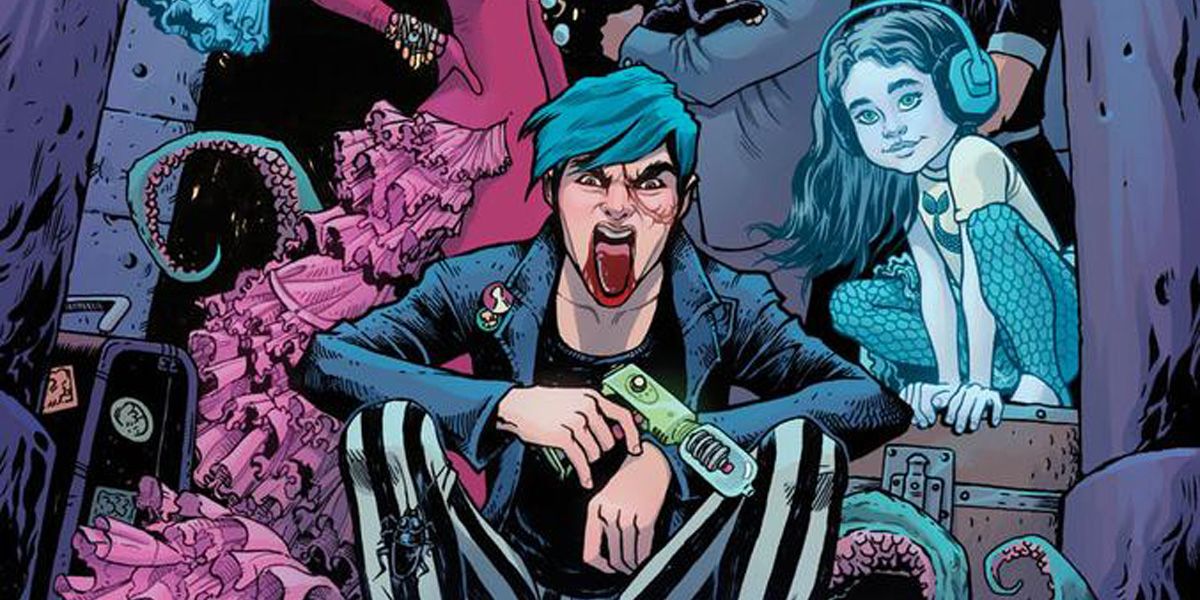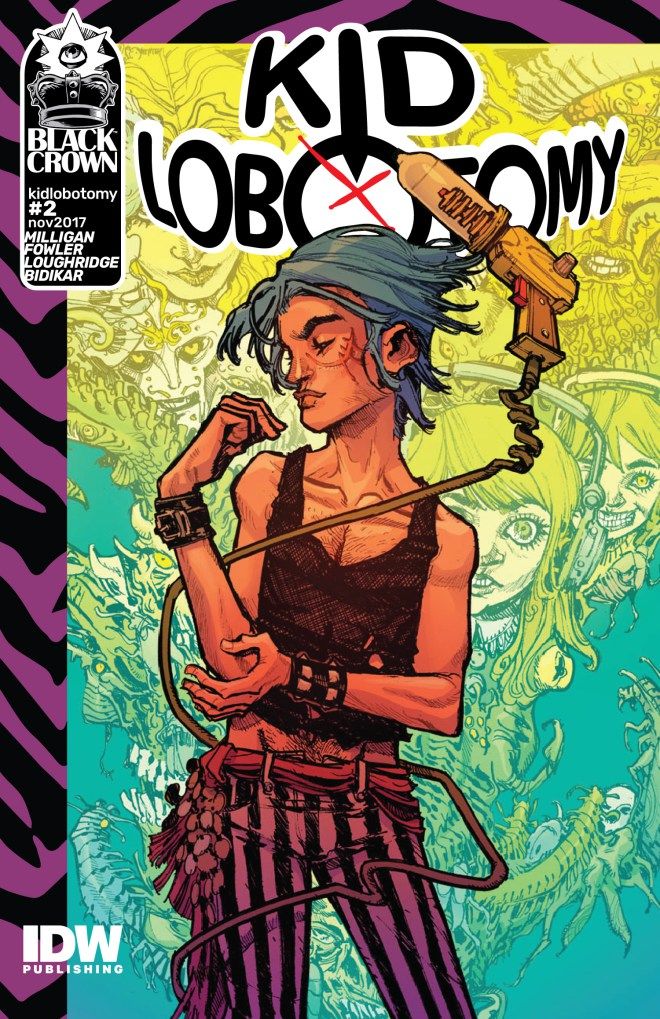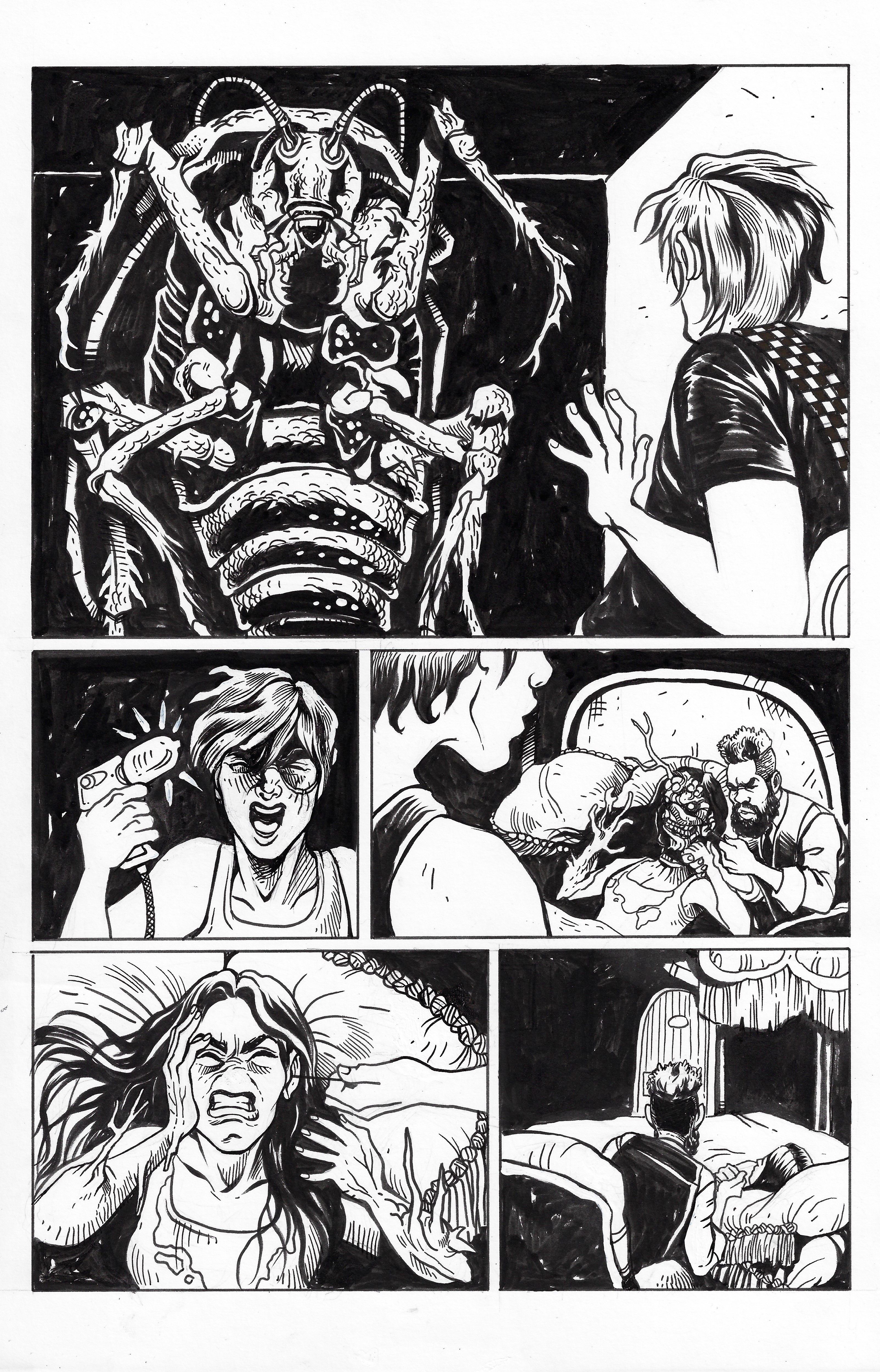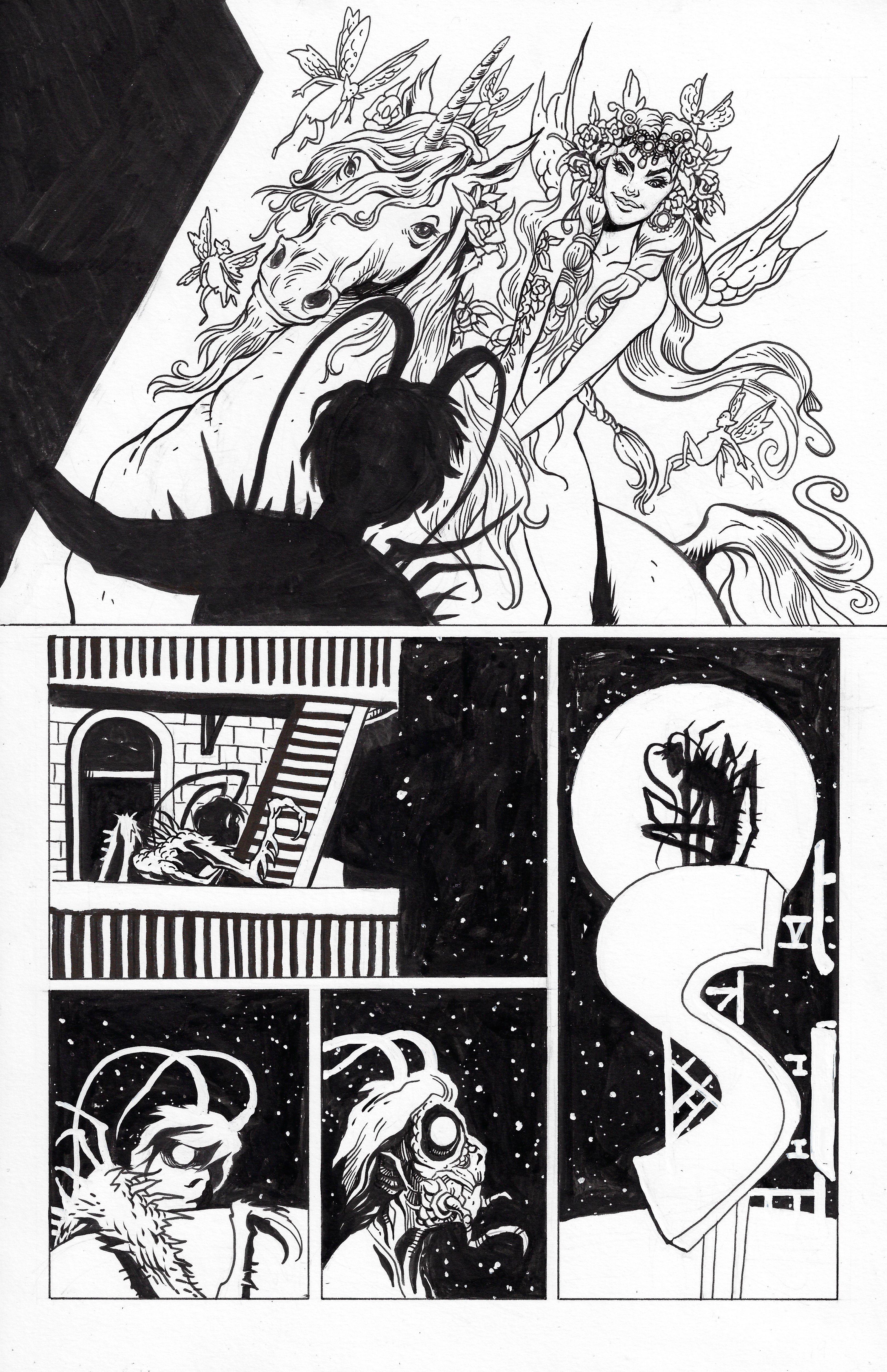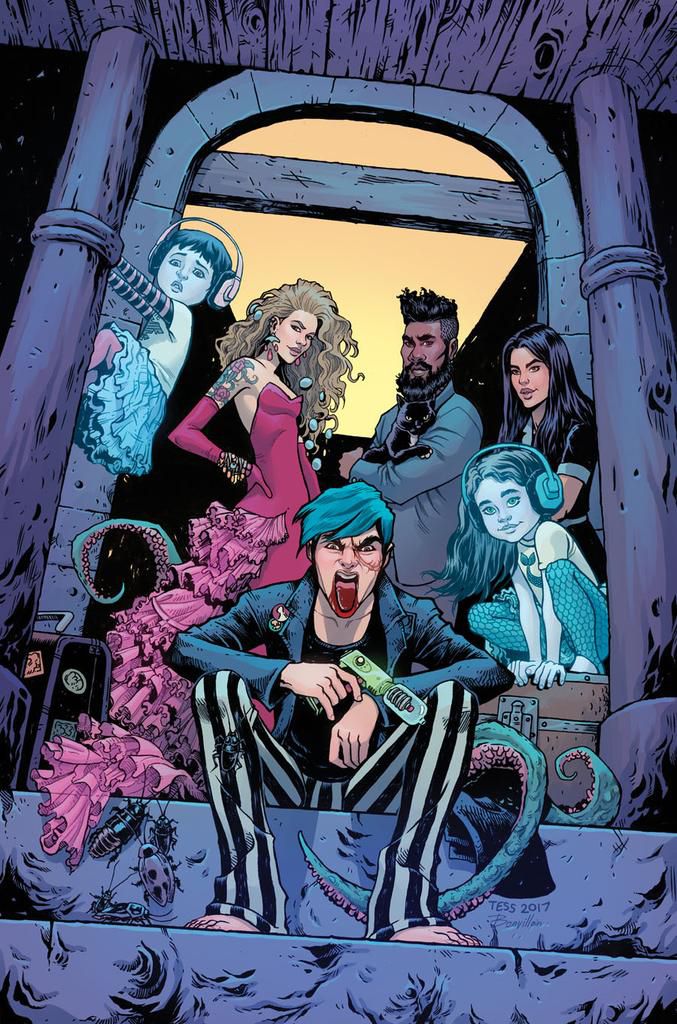When IDW Published announced the launch of a new imprint run by Shelly Bond called Black Crown, the big question was what kind of imprint this would be. Bond, one of the most respected editors in the industry today following her work at Vertigo, could go in any direction -- but with the announcement of Kid Lobotomy as the Black Crown launch title, she caught everybody off guard once again.
Pairing writer Peter Milligan with artist Tess Fowler, Kid Lobotomy is set in an offbeat hotel known as 'The Suites," run by a hugely dysfunctional, dark-minded family. Chief amongst them is the Kid of the title, a young man who is assigned ownership of the hotel -- but whose past includes multiple brain surgeries and a whole load of drink and drugs.
Taking his role as manager as an opportunity to try and reclaim his demons, Kid's journey brings Fowler and Milligan into a uniquely strange, off-kilter comic -- and CBR spoke to them both about how they entered 'the Black Crown Pub' together, and what sort of strangeness readers should expect from their series.
CBR: How did you both enter Black Crown together?
Peter Milligan: I received an email from my old co-chiseller at the rock-face of comics, Shelly Bond, telling me what she was trying to set up at IDW. It all sounded great. The email was titled "HEY LOBOTOMY", for her own amusing and enigmatic reasons, and we started bouncing round emails, ideas started to quickly come... but that word Lobotomy stuck in my brain, as it were.
Tess Fowler: Shelly had already pulled me in for the Femme Magnifique anthology, as well as a side project she had been brewing. So when Black Crown came to be, I was in the stable ready to work.
In interviews Shelly has described Kid Lobotomy as “classic Milligan”. You’ve worked for a number of publishers over the last few years, but was it freeing to get to spiral into a series with Shelly once more?
Milligan: “Freeing” isn’t the exact word I’d use when working with La Bond, but what has been great about working with Shelly on Kid Lobotomy is we both have a good idea what kind of book we want to produce. That’s rule number one: that writer and editor understand what each is trying to achieve. That’s not to say that Kid Lobotomy is one of those books that can be summed up in one word -- it’s too insane, it’s too genre-hopping for that.
Being the launch title for Black Crown, this book gets to set a tone for the imprint as a whole -- but what kind of a tone does the story have? Is this serious, sardonic, grim or free-wheeling?
Fowler: All of the above. But mostly I'd call it absurdist gothic horror hog-tied by a '70s punk fairytale.
Milligan: This is a book that covers the spectrum of tones, or emotions. Dark comedy, horror, love. Yes, there is weirdness here, but that means little if it doesn’t coexist with emotion and characterization. I suppose my point is, real life is weird. Our thoughts, dreams, nightmares, they’re often very bizarre. So it’s not like we’re trying to be deliberately weird for weird’s sake here. This is life. At least, it’s life if you’re someone called Kid Lobotomy.
Thematically, what can we expect from Kid Lobotomy? It initially seems as though your interest here is in exploring independence and control?
Milligan: At the heart of Kid Lobotomy is the theme of self-discovery. Who am I? Where do I come from? What has made me the way I am? Why is there a skeleton buried in the basement? Surely, these are all questions we’ve asked ourselves, and these are the problems that Kid Lobotomy wrestles with in his own unique fashion. So yes, we’re exploring identity, we’re exploring that dangerous but fertile liminal ground between sanity and madness, between the real and the imaginary.
Who is the Kid, the eponymous lead of the story? What kind of a life does he have as the series kicks off?
Milligan: Kid is a failed rock star, an ex-mental patient, an occasional neurosurgeon, a dreamer, and now the manager of one of his family’s hotels: the Suites. The Suites is no ordinary hotel and Kid is no ordinary manager.
Fowler: He's a troubled young man… or is he?
This is, at its heart, a black comedy. His life is absurd.
What was your approach to the design of the Kid, and “The Suites”, when planning the book? Did you want this to be a contemporary or classical world?
Fowler: The Kid is largely inspired by young Mick Jagger. Which was Shelly's idea. She sent me a photo of him as a slightly haunted fresh-faced young man, and I took it from there.
The Suites is inspired by various Hollywood hotels. I live in Los Angeles and I'm madly in love with the grim dark history around every corner. So I went on a fact-finding mission armed with a camera phone. My husband ran into Susan Sarandon in an elevator on that trip. Hollywood is full of surprises. The Suites is also inspired by our recent trip to the UK. You'll see hints of that peppered throughout. London and Edinburgh seeped into my soul. As for it being new or old? It’s all of the above. On purpose. I want you disoriented.
Milligan: When we begin the series, Kid has not yet been given the hotel to run, nor in his wildest dreams (and Kid has a few wild dreams) does he think he’ll end up as manager. But a series of unforeseen events leads our Kafka-obsessed hero to believe and hope that the Suites might be the key to his sanity. This is a bit like trying to put out a fire with a bag of gunpowder.
It feels like The Suites, where he’s holed up, is a particular choice you’ve made for the setting. Why put him in a confining place like this?
Milligan: I don’t see it as confining. A human brain, just 15 centimeters long and weighing in at about 3 pounds contains an entire universe. And all life -- at least, just about all Kid’s life -- is in this hotel. This is the place where Kid grew up and its many rooms, floors, and shadowy nooks are a repository of memories, traumas, and long-buried secrets. The hotel is in a many ways an extension of Kid, and a great way for him to explore himself and what his life means.
Fowler: And the Black Crown pub is right next door. Where else is he going to get his scotch?
How’ve you found working together on the series?
Milligan: Tess is great to work with. Full of ideas and creativity. A revelation, in fact. She’s a young woman living in Los Angeles so she brings a young, and an American, sensibility that I think is a vital ingredient of the book. Of course none of this means a thing if the art isn’t up to scratch, and Tess’ art is terrific.
Fowler: I had nightmares for the first few months! But I'm increasingly charmed by the madman. Each new script is a reason to remain in The Suites, following Mr. M into new levels of hell. I'm learning so much from him.
Do you feel that working with him on the book has changed your artistic approach at all?
Fowler: Mr. M is driving a jalopy around hairpin turns in a graveyard at midnight, and I'm just the kid in the passenger seat trying to shine flashlights in the faces of whatever undead nightmare goblins he awakens. But usually the goblins are funny. Witty. Not so scary after all. The ride itself is what freaks me out. And therein lies the challenge.
And has Tess surprised you with her approach on the book? When writing you have one thing in mind, but what’s it been like to see her bring the weirdness to life on the page?
Milligan: There have been surprises, but good ones. For example, Kid has a sister -- Rosebud, who is a vital character in the book -- a Goneril to Kid’s Cordelia, if you will -- and the way Tess visualized her was very different from how I imagined her. But that’s great, that’s adding a different spice to the dish. As soon as I saw Tess’ Rosebud I was sold. These are good surprises, good creative surprises.
Amidst the hallucinatory excess and lobotomies, this seems like a comic with a sense of heart beating away through the corridors. How do you feel Kid Lobotomy stands apart from anything you’ve worked on before?
Milligan: Heart is vitally important for me. True emotion, true feelings. Without those, the rest is just sound and fury. I think I’ve usually tried to connect to these in my comics, from Shade the Changing Man to Hellblazer I’ve tried to locate and hone in on the human emotions, albeit amid a storm of strangeness. In that way, Kid Lobotomy is related to my former work. I suppose what makes this feel different is the more gothic or even classic horror territory (the fading hotel, the brain operations, the madness, etc.) and the focusing on what is a family drama, though one set against the backdrop of Kid’s journey into the lower depths of the strange hotel wherein the terrors of his past await.
Fowler: A sense of heart, yes. But more than anything it’s full of dark, absurdist humor. Beyond the scary, beyond the sweet, it's funny. Or maybe I've just spent too long with Mr. M and now I'm twisted too.
Kid Lobotomy #1 is scheduled for release on Oct. 18 from IDW Publishing.

